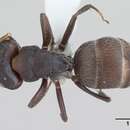pt-BR
nomes no trilho de navegação


This species inhabits wet to moist climate areas, in mature forest or second growth vegetation. In lowland sites it can occur in both mature and second growth forest, but at higher elevations is increasingly restricted to open or disturbed habitats. Workers are diurnal. The species is relatively common in canopy fogging samples at La Selva Biological Station.
Nests are in narrow-guage dead stems. Most nests I have encountered have been in stems 4-10mm outside diameter. Nests can be populous: a nest I found in a dead Cecropia petiole lodged in low vegetation contained 319 workers. Nests commonly occur in low vegetation, so the species is frequently encountered and collected.
Costa Rica, Panama, Colombia (type locality), Trinidad, Brazil (GB, RJ, SP), Paraguay. Costa Rica: throughout country to about 1000m elevation.
Taxonomic history
Combination in Camponotus (Myrmobrachys): Forel, 1914a PDF: 270.Status as species: Dalla Torre, 1893 PDF: 230; Emery, 1896j PDF: 377 (in list); Forel, 1911g PDF: 291; Forel, 1912j PDF: 78; Wheeler, 1916f PDF: 330; Luederwaldt, 1918 PDF: 51; Wheeler, 1922e PDF: 16; Emery, 1925d PDF: 163; Kempf, 1972b PDF: 52; Bolton, 1995b: 98.Alto Paraná , Canindeyú (ALWC, IFML, INBP, LACM). Literature records: Cordillera (Forel 1911b).
Camponotus excisus is een mierensoort uit de onderfamilie van de schubmieren (Formicinae).[1][2] De wetenschappelijke naam van de soort is voor het eerst geldig gepubliceerd in 1870 door Mayr.
Bronnen, noten en/of referentiesCamponotus excisus é uma espécie de inseto do gênero Camponotus, pertencente à família Formicidae.[1]
Camponotus excisus é uma espécie de inseto do gênero Camponotus, pertencente à família Formicidae.